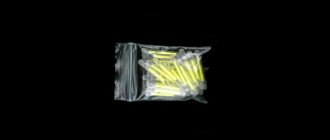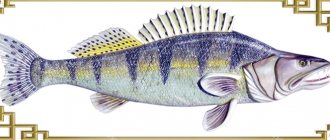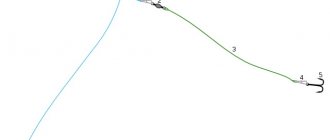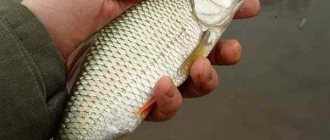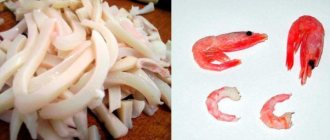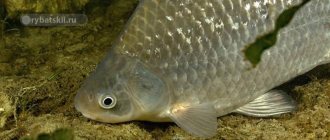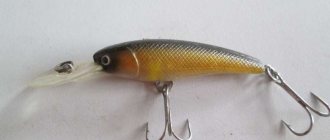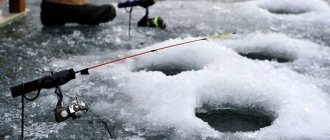10/16/2016 admin
Spinning fishing during river rafting is a rather delicate thing. Of course, you can treat it simply and unpretentiously - fish from a drifting craft, without bothering, all the areas you like along the route. I have two rafting routes along the Ob River and its channels. The first takes place in the Shelabolikha district of the Altai Territory, not far from the village. Shelaboliha . The second route along the Ob in the Novosibirsk region near the village. Suzun . However, practice shows that such adventurism, if it can bring success, is only with great luck and in the summer.
In autumn everything is different. Although pike has a good appetite (under favorable conditions), it is still not ready to rush headlong at everything. In addition, the horizon of the toothy predator’s parking area is now significantly lower than the summer one, so the fisherman will inevitably have to spend time on each cast to deepen the bait.
Pike, although not a schooling predator, still becomes more concentrated in promising areas as the weather gets colder. In this regard, fishing “by area” and in many ways “by luck” is even less effective than ever.
In general, the actions of a pike during autumn river rafting should not only be conscious, but also correspond to the place and time. I will highlight three key points that allow you to find a common language with the not so accommodating autumn river pike: fishing tactics, parking places and bait.
Pike fishing tactics on the Ob in October
A long time ago I became convinced that a correctly constructed fishing scheme (aka fishing tactics) often carries much more weight than other components of the art of fishing. This is doubly true for autumn. Even before the first cast, I more or less know (not always, of course), which places I will bet on. In the vast reservoirs of pike points (known to the fisherman, in any case), there are sometimes a limited number of them, but on the river there are clearly more of them. Much is clear visually, often even a clear picture of what is happening under water. It would be nice to have a plan “B”, but for now it is enough to imagine how we will implement plan “A” in the next hour or two. Much will become clearer later.
Fishing tactics, in my understanding, include a lot of subtleties that are linked into some logical, conscious system. Without insisting on anything at all, I will share the tactics that I usually use.
- Option 1. In driftwood. For fishing, I choose snags near the shore, where the depth is not less than the average depth of the river in the vicinity. The fact is that snags located at a depth sufficient for a predator to stay there comfortably are very likely to be inhabited. At the same time, in the fall we can count on the pike to quickly respond to our efforts and bite. Not only does the coastline continue to attract predators, but it even more accurately ensures the “readability” of the area. Often, even a flooded snag is easily identified by an angler who is fishing here for the first time. In October, I usually use jig baits with an offset hook, but I think that rigid frames are not appropriate here. The tactic option under consideration involves moderately quick fishing of the area you like, often with lowering the anchor. On average, it takes me about 10 minutes to make a piece of snag, say 5 m wide and 10 m long.
- Option 2. According to the relief. Initially, I build the rafting route in such a way that most of it passes through an area with sharp changes in depth, but without snags. In practice, you usually have to deal with channel edges or the edges of holes where pike often stand. For a more or less complete implementation of this tactic, knowledge of the area is important, because even two dozen hooks during fishing plus the same number of casts at random will not have the best effect on the overall result. Fishing on the edges and in their vicinity is most logical with jig baits, but deep-sea ones are also quite relevant wobblers. In some areas, it is even advisable to troll if you want to somehow diversify your fishing or try to start a dormant predator with the roar of the engine. Of jig baits, of course, it is safer to use “non-hooking” ones, but sometimes open hooks are justified. I don't go small with baits. October is the time when schools of bream, roach and other forage fish ply in search of shelter for the winter, so our bait should not look less nutritious than the usual pike menu. In a good way, if the edge is more or less the same type, it is not entirely rational to fish the same area even with two casts. Although autumn requires leisurely action, when river rafting, I think it is better to catch more new places, albeit not as well.
- Option 3. Point. I pay attention only to potentially promising points that have previously given me pike or look promising. Of course, such tactics are easier to implement on familiar terrain, when it is clear in advance what the number of pike places is and how much time can be devoted to each of them. In view of the very good visual “readability” of the underwater relief (I focus on the strength and direction of the current, the outlines of the coast, plus the water is already clear), it is quite possible to discern a promising place in advance even in an unfamiliar water area. This variant of tactics, unlike the previous two, involves fairly detailed fishing at some points and completely ignoring others. So I can fish a pike edge, pit or snag for 15-20 minutes, but in the next 300 m of the river I won’t even cast. The easiest way to implement the above is with an engine. To avoid excessive noise, I use an electric motor. It turns out slowly, but confidently. This is quite enough for rafting and realizing literally all my “river plans”. I use spot fishing tactics, first of all, when there is a noticeable contrast in the degree of prospects between neighboring places. That is, there are both clearly defined points and obviously “dead” areas. For this kind of fishing, it is quite appropriate to fish both with jig baits and by twitching with wobblers. Often it is a radical change in style that leads to a confident bite. Possibility of making a mistake? No one is immune from this, but in the autumn season the probability of a miss is lower than usual.
- Option 4. Combined. Of course, there are a number of situations when it is necessary to create a certain mix from the above. Let's say a long river run with a distinct channel edge gave way to a local snag, which clearly deserves more time. It can be saved if, for example, you completely abandon fishing in the neighboring sandy shallow waters, where with the cold weather it is difficult to encounter a predator. In my case, the combined option is often implemented for another reason that the initially chosen tactics are not always optimal. Well, the snag is not working today, or the number of dead hooks is so great that there is very little time left for fishing, but the edge produces excellent pike over and over again... What is the point of running into the snag then?
Seasonal fishing features
You can successfully fish on the Ob both in open water and from ice. The species composition of caught trophies will depend not only on the type of gear used, but also on the season.
Spring
Spring open water fishing begins on the Ob in early May. The angler's hook catches a roach that is severely exhausted after a long winter and is in a hurry to replenish its vitality before spawning.
On a note! In spring, roach should not be looked for in the same areas where it was caught in winter. Large flocks of sorog can be found in flooded meadows and floodplain lakes. In shallow areas, the water warms up much faster, which contributes to the concentration of potential fish food items.
In areas flooded by flood waters, roaches can always find earthworms, which are their favorite delicacy. In addition, pike caviar is already present in such places, and the fish actively eats it.
In recent years, large pike perch have become more common on the Ob River.
To catch roach in the spring, it is better to use a fly float rod. The equipment should be adjusted so that the nozzle is in the middle layers of the water. The following can be used as bait:
- worm;
- maggot;
- bloodworm;
- bark beetle
Active roach biting in shallow water continues until the water warms up to 15 degrees. In June, these fish move to deeper areas and it becomes much more difficult to catch them.
In the second half of May, pike begin to eat. Having recovered from illness after spawning, the predator feeds heavily and greedily rushes to artificial baits and natural baits. In the spring, it approaches the shores and hunts spawning carp fish.
Pike can be caught with a float tackle, using roach or crucian carp as live bait and casting the rig closer to the reed beds. However, the most interesting thing is spring pike fishing with spinning tackle. The most suitable baits for this season are:
- minnow-class wobblers 8–10 cm long and up to a meter deep;
- unloaded vibrating tails of natural colors;
- silicone imitations of frogs;
- rotating spoons No. 2–3.
The spring feeding period of pike lasts for two weeks. Having restored its vitality, the predator returns to its usual habitats.
In spring, you can also count on a good bite from ide and medium-sized perch. These types of fish are caught using light spinning tackle. Lures can be:
- rotating spoons No. 0–2;
- shad class wobblers no larger than 5 cm;
- small twisters on a light jig head.
When fishing, you should focus on the splashes that the predator creates during the hunt. If you place the bait accurately, the bite will follow immediately.
Places where predators gather
At first glance, the conversation about pike camping sites on the autumn river has absolutely no novelty or originality, however, in relation to rafting there are still some nuances that, in my opinion, are worth pointing out. It sounds somewhat strange, but it is not rational to fish all traditional pike points during rafting; sometimes it makes sense to leave some without attention, but to examine others, where the efficiency of our actions is predicted to be higher, more carefully.
I will describe the most promising places not only from the point of view of the presence of pike there, but also the ease of fishing. I will give the main role to a small snag that has no analogues nearby. I have long been convinced that even a single branch or log can serve as a reliable shelter and even a place of residence for a seasoned predator. The advantage of the autumn river snag is that there is a high probability of catching a “duty” specimen on the very first casts, that is, one that is ready to eat our bait without preludes or hesitation.
However, not every snag deserves attention during rafting. Moreover, it is not reasonable to fish every such place in detail, even if there is a predator there. I am inclined to think that it is better to fish three promising places without blind hooks than one with constant breaks and tying of baits. Relatively deep coastal areas with remnants of vegetation on the bottom are very interesting for pike. In October, the water is usually so clear that with polarized glasses you can see what is even at a depth of 3 meters.
If you can see the remains of a water lily or other plants at the bottom, it’s worth fishing in such a place. It is quite possible to use jig baits (the vegetation is now weak and pliable), but twitching over the grass works very well. The optimal depth for fishing in such a place is approximately 3 m. Sometimes the pike goes to the shallowest water (1-1.5 m), but this happens rarely, so I don’t rest in such areas for a long time,” if there is no answer.
Coastal areas with bushes hanging over the water and stumps protruding separately from the water do not lose their relevance in October, although it seems that these places are more likely to be summer. According to my observations, already a 2-meter depth near the shore is enough for pike to hide here in October and even later. I admit that the number of specimens near land is not the greatest, but catching them is quite easy. In addition, the coastline can be easily and effectively fished from a drifting or moored boat.
At shallow depths, the choice of baits is perhaps the widest. Silicone, wobblers and even spinners can bring success. If there are sandy, or better yet shell, spits on the chosen route, they cannot be ignored. I don’t remember a “pike gathering” in such places, but I regularly caught one or a couple of active predators there. The river spit is also attractive because it can produce trophy pike or good pike perch or pike perch as bycatch. In addition, in its vicinity there are usually single predators, but actively looking for prey.
In October, coastal areas overgrown with reeds sometimes perform well on rivers. The chances of success are especially high if there are very few similar places. During rafting, I almost always move 5-6 m from the edge of the reeds, and I try to place the bait as close to the thickets as possible. These places acquire particular relevance when the border of the reeds is no further than 3-5 m from the riverbed or hole, and near the very edge of the thickets there is a depth of at least 1.5 m. At a depth of up to 2 m, I do not hesitate to fish with wobblers, when deeper, use jig baits.
Over many years of fishing, I have developed a small rule. If the area of coastal reeds is local and there is depth nearby, I fish the entire border of the thicket. If the reed strip is long or the coastline is bordered by it, I check such places selectively. Now, if the pike shows itself, then I’ll make a solid bet on the thickets.
As at other times, the confluence of streams or separate branches of the same river are very interesting. Fishing is especially successful when there is a clearly defined channel of the inflowing stream. The pike likes to hang on to its edges. Usually 1-2 stationary police and 15-20 min. There is enough time to check this place. And then, after a couple of casts, you understand that the pike is here, and the only thing left to do is to seduce it.
Once, while analyzing my autumn fishing diary entries, I tried to numerically express how much the pike moves downwards with the arrival of autumn. It turned out that for those rivers where I fished both in summer and autumn (otherwise there is no basis for comparison), the downward shift was approximately 2 m. In other words, for the initial search for the pike horizon, it is worth focusing on the depth that “worked” in the summer, adding 1.5 2 m to it. For autumn I got 3-4 m.
Despite the general tendency for predators to descend to depths as the weather gets colder, I almost never fish holes during rafting. Firstly, according to my observations, most often there are just passive and fastidious specimens, which, if they bite, do not bite immediately and not on all baits. Secondly, fishing at great depths will inevitably take longer than usual, and with absolutely no guarantee of results.
Various imitations.
Of course, it is impossible not to mention such a common bait as foam fish.
To equip jig baits, it is advisable to use high-quality hooks. And it won’t hurt to replace the tees on wobblers and spinners.
Be sure to pay attention to leashes. I myself only use 0.5 mm thick nichrome wire.
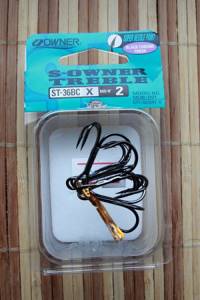
A wide range of models, a variety of colors, many installations, the ability to fish at any depth, high attractiveness to fish, stable operation at any fishing speed - all this gives silicone a place of honor in my fishing box.
Working lures for pike fishing on the Ob River in October
Perhaps, not a single article about pike will look complete if we do not remember the baits on which, hopefully, the object of our hunt will deign to bite. It’s not for nothing that there are a great many of them, although it is quite obvious that the working box of a successful pike fisherman may well consist of a dozen proven models. This is true for autumn river rafting. I'll share my experiences.
Silicone baits. For me, this is the key type with which I go for pike at almost any time, but especially in the fall. Key, but not the only one. “Silicon” is interesting for pike in the fall because, among other things, it has a very seductive game at low speed. Those same notorious pauses during step-by-step wiring are now in demand threefold, because the spotted predator previously honored this stage of wiring most of all, and even more so in the fall. For myself, I have long concluded that the pike decides to attack mainly when it is sure that the prey will not leave, and the energy spent on the throw is fully compensated by the calories from the eaten prey.
During river rafting there is not much time or opportunity to experiment, so it is more reliable and rational to use only proven models. vibrating tails in first place . I think larger “silicone” ones will also work, but I’m not into those. My fall favorites among vibrotails have long been SAWAMURА One Up Shad, BAIT BREATH T.T. Shad, NOIKE Ninja.
When fishing at a depth of up to 3-4 m, I rarely use jig heads heavier than 10-12 g. And only when fishing, for example, the lower part of a riverbed slope and, less often, pits, do I use a weight of up to 18 g. I trust vibrotails even when It is not known in advance where the predator is hiding or when I am fishing in unfamiliar waters.
Twisters are a good alternative to vibrating tails. Their playing is much softer and more measured. They clearly show the autumn fat that its victim is doomed and unable to escape. The illusion of this helplessness, I think, is the first reason why twisters are sought after by predators. When it comes to spot fishing in a specific place or catching a pike that has bitten but missed another bait, twisters, as well as their derivatives, are often out of competition. Both me and the pikes have long liked TSUNEKICHI Hama Grub, BAIT BREATH Curly Grub, Bugsy, BETANCO Curly Tail, Slim Curly.
Again, when fishing at specific points (for example, in snags), sometimes you have to surprise the pike or offer it something that colleagues and spinning anglers previously did not bother to throw into the water. There are a great many original solutions among silicone baits, but not all of them are interesting to pike in the fall. I repeat: this time is not the time for experiments either for the pike or for the spinning angler, so if it is worth being original, then in moderation. In general, if something new should be offered, it should be done wisely and necessarily from what has already been tested before. Among my incoming delights are FISH TAIL Shad, U30 FishCurly, SL-Remix.
Favorite wobblers for Ob pike in autumn in October
Some of my friends are firmly convinced that from the second half of autumn wobblers almost completely lose their relevance; others do not believe (and sometimes prove this with excellent results) that they can be fished all year round and almost everywhere. My preferences are somewhere in the middle, so in October I still use solid baits, but at best only on a third of my fishing trips. This is mainly twitching with minnow wobblers. In principle, if the depth does not exceed 3-3.5 m, this technique is quite successful. Another important condition for proper twitching is the relative cleanliness of the water area from snags, otherwise you won’t have enough time or bait.
The general pattern of the game that I set for my minnows fits perfectly into the concepts of smooth and soft. As in the case of fishing with silicone, the pike does not need to make it clear that its prey is capable of escaping. I try to refrain from using provocative and acidic colors. Of course, sometimes these are exactly what the pike wants, but in general I am of the opinion that calm natural colors are more reliable and catchy. The optimal length of wobblers is 110-130 mm.
Of course, no one has abandoned the classics, such as the OSP Rudra 130SP, DEPS Ballisong 130SP or ZIP BAITS Orbit 110SP, but I have been getting along just fine with much more budget-friendly models for many seasons, which are not so painful to leave on the next snag. Among such minnows, the leading ones are MEGABITE Dandy 125SP, Amigo 110SP, LIBERTY Mystic 120SR.
Of course, you can really achieve results not only with minnow wobblers or jig baits. I think that with due persistence, faith and effort, a pike can be caught even with an alarm clock or a doorknob. True, I haven't tried it.
Observations from fishing practice on the behavior of pike in October
Instead of a conclusion, I will share some important observations from practice, which personally saved my fishing many times, or even made me feel triumphant.
- The October day is quite short, but literally at any moment, with the exception of evening twilight, you can expect a surge in pike activity.
- During rafting, literally every new turn of the river opens up its own promising points for the fisherman. The most obvious of them, of course, are stupid to ignore, but it often makes sense to filter out those characteristic similar areas where there were no bites, concentrating on similar ones where the fish were caught. In autumn, the pike population is quite consistent in its preferences and behavior.
- No matter how attractive the place looks, even if you caught fish here yesterday, if there is now a complete lack of pike reaction to our efforts, it is better to change it. In autumn, the predator is active and is able to reward you with a bite on the very first casts at the next point. According to my statistics: if the point “did not respond” in the morning, it will be of no use in the evening. Pike move little in October.
- If a section of the river gives small pike one after another, there is a very high chance that there are simply no large specimens on it. Sometimes a worthy predator is located somewhat to the side (say, at the other edge of the pit), but not among the little things.
- Places near schools of roach, silver bream or bream deserve special attention. They can be seen even without an echo sounder if there is shallow water under the boat and the bottom is light. It’s unlikely that there won’t be a shepherd pike nearby.” In a word: a school of forage fish is a sure sign of the presence of a predator. Usually the latter watches for prey nearby and either from a shelter or near a bottom drop, where it is also possible to remain relatively unnoticed.
- Often, fishing a place you like takes much longer than the boat drifting with the current, but I try not to unnecessarily lower the anchor overboard. This way, time is saved, there is less noise, and the pike will not catch the anchor rope.
- It is known that with cold weather, pike gravitate to deeper places, but it is not uncommon for a pike to stand at mid-levels, or even in shallow water. It makes sense to fish such shallow areas first, because they contain the most active specimens.
- Often you can quite clearly trace the trend when pike prefers a certain type of bait, treating others coldly. For example, oh, while the wobblers are silent. At such moments, you shouldn’t try to break the pike’s preferences - it’s wiser to adapt yourself.
- The influence of weather and other external factors on pike appetite was a thing in itself at another time, and even more so today. I am sure that in literally any weather conditions (comfortable for us and not so comfortable) there is a great chance of catching a pike bite.
- In October, and even from a boat, you can fully count on the next promising place to offer simply enchanting fishing with lots of bites and catches. But let’s not forget that this is not the last time we fish, and certainly not for the sake of a bag of loot. Being able to release a fish is not the least important quality of a proper and modern spinning rodist.
Have a great fall fishing trip and only positive vibes!
What kind of fish is caught in the Ob and where is the best place to fish?
Fishing on the Ob at any time of the year will not leave you without a catch; You can easily catch crucian carp, carp, bream, perch and even pike using almost any tackle.
Ob is a river in Western Siberia. The river is formed in Altai by the confluence of the Biya and Katun rivers - the length of the Ob from their confluence is 3,650 km, and from the source of the Irtysh - 5,410 km. The Ob and Irtysh are the longest river in Russia and the fourth longest in Asia. In the north, the river flows into the Kara Sea, forming a bay (about 800 km long), which is called the Gulf of Ob.
It flows through the territory of the Altai Territory, Novosibirsk Region, Tomsk Region, Khanty-Mansiysk Autonomous Okrug and Yamalo-Nenets Autonomous Okrug.
Fishing has long been developed on the Ob. Fishing in these parts is unforgettable. The Ob, and especially its lower part, is considered by fishermen to be a real fishing paradise. Moreover, due to the cooler weather, many of them prefer the first. The most catchy places are precisely located from the confluence of the Irtysh to the Ob Bay itself.
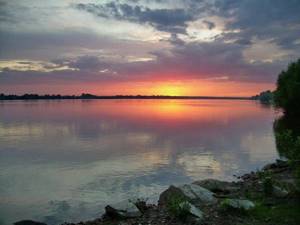
Many local anglers are more likely to catch whitefish using float rods. For this purpose, they are selected at the mouths of small tributaries flowing into the Ob. In such places, almost everywhere there are small holes, the entrances and exits of which allow you to always catch enough fish.
In such pits, especially towards the end of summer, there are dense flocks of leucorrhoea, which, on the eve of winter, come here to feed. What is typical is that it is not possible to “tie” this mass of fish to one place with bait. It lives according to its own rhythms and moves only in directions and times known to them. Having caught 8-9 fish, you can safely go to another place; the bite usually ends there.
Whitefish are caught mainly with match rods, suitable in the conditions of the Ob River for fishing from the shore, in places remote from it, in still water and in wiring. At the height of the summer season, maggots, especially their plant species, are popular baits. Closer to autumn, it is better to use shitica, granny larvae, and worms. In extreme heat, local fishermen always use shell meat.
In the Ob, throughout the year you can easily catch crucian carp, carp, salmon, bream, perch, and after a flood (usually in the spring, since the river is mostly filled with melted snow) you can even be lucky with catching pike.

Crucian carp.
Crucian carp is a genus of ray-finned fish of the carp family. The dorsal fin is long, the pharyngeal teeth are single-rowed. The body is tall with a thick back, moderately compressed laterally. The scales are large and smooth to the touch. Coloration varies depending on habitat.
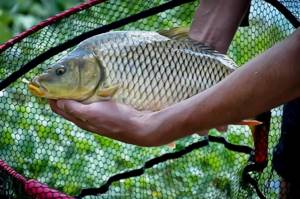
Carp.
Carp is a beautiful, strong fish with large scales shimmering in dark gold. The outline of each scale is outlined with a black border. The elongated body of the fish has a thickening in the front part. A large dark gray dorsal fin with a serrated ray runs along almost the entire back of the fish.
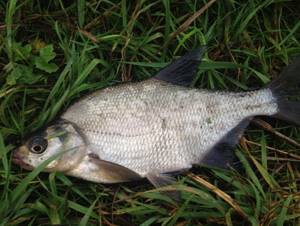
Bream.
Bream is a tasty and healthy fish that is popular not only among fishermen, but also among consumers. If you wish, you have the opportunity to start breeding and growing fish in your own pond. Fishing for bream is considered an exciting activity, because during fishing it is required to maintain silence, which adds more intrigue to the process itself.
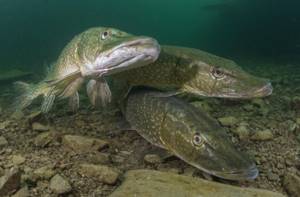
Pike.
The pike fish is our freshwater shark. There is probably no person in Russia unfamiliar with pike fish. Almost everyone knows her from childhood from the ABC book, in which the pike personified the letter “Sh,” fairy tales, coloring books, fables, riddles, and cartoons. Perhaps that is why even those who have never held a fishing rod recognize it at first sight.
Large predators are caught near channel edges on the river, and they visit existing holes and pools in the reservoir. Those who do not purposefully count on trophy fish fish places located closer to the shore, near the walls of aquatic vegetation and reed thickets.
Numerous channels, creeks, and backwaters are promising for catching medium-sized pike.
Let us remind you that earlier Sib.Fm told how to properly celebrate the Orthodox holiday of the Transfiguration of the Lord, also called Apple Savior.
